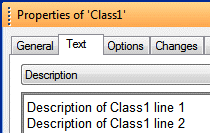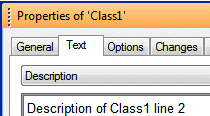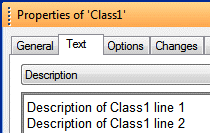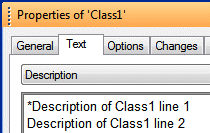|
Reverse engineered code
|
Modeler
|
|
//Description of Class1 line1
//Description of Class1 line2 public class Class1 { } |
 |
|
Reverse engineered code
|
Modeler
|
|
//Description of Class1 line1
//Description of Class1 line2 public class Class1 { } |
 |
|
|
Note that the Reverser uses white space to delimit preceding comments. For example, if in the preceding example there was white space between the two comment lines, only the second comment would be reverse engineered.
|
|
Reverse engineered code
|
Modeler
|
|
//Description of Class1 line1
//Description of Class1 line2 public class Class1 { } |
 |
|
Reverse engineered code
|
Modeler
|
|
/*Description of Class1 line1
Description of Class1 line2*/ public class Class1 { } |
 |
|
Modeler
|
Generated code
|
 |
//Description of Class1 line1
//Description of Class1 line2 public class Class1 { } |
|
Reverse engineered code
|
Modeler
|
|
/**Description of Class1 line1
Description of Class1 line2*/ public class Class1 { } |
 |
|
Modeler
|
Generated code
|
 |
/**Description of Class1 line1
Description of Class1 line2*/ public class Class1 { } |
|
Reverse engineered code
|
Modeler
|
|
// Preceding comment
public class Class1 // Inline comment { } |
 |
|
Modeler
|
Generated code
|
 |
// Preceding comment
// Inline comment public class Class1 { } |